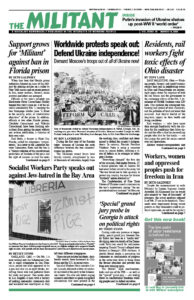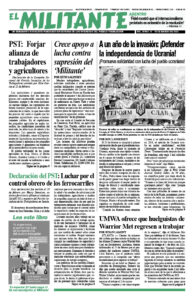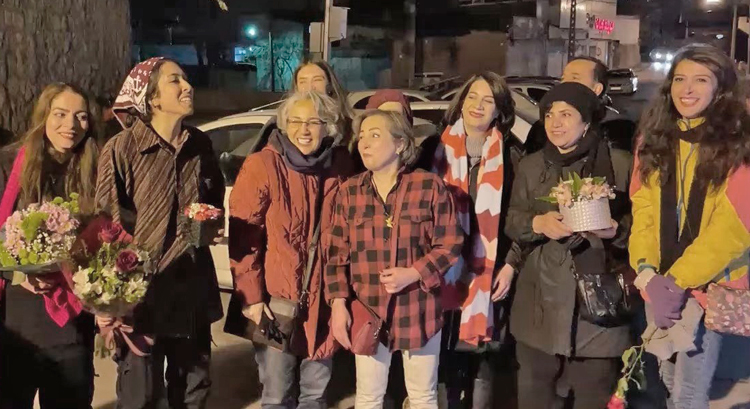Despite the announcement in early February by Iranian Supreme Leader Ayatollah Ali Khamenei that he would give amnesty to “tens of thousands” of prisoners, the actual numbers released as of Feb. 27 are in the hundreds. Thousands were imprisoned during recent protests as they demanded a halt to political repression, an end to the regime’s abusive treatment of women, and equal rights for oppressed nationalities, and as workers stepped up union struggles.
But judiciary spokesperson Massoud Satayshi claimed that “most of the accused and convicts will be released” soon. A coalition of 20 independent unions, cultural organizations and student groups is demanding that all the political and union prisoners be released.
Despite brutal prison conditions, many of those who have been released come out unbroken, confident and ready to press forward the fight for political rights.
Seven women political prisoners were greeted with flowers and cheers by supporters when they were released from Tehran’s notorious Evin prison Feb. 9. After walking out of the prison, without covering their hair, the women stopped to have their picture taken as they chanted “Women, life, freedom!”
Mohammad Habibi, a spokesperson for the Coordinating Council of the Iranian Teachers Trade Union, was released from prison Feb. 8 after nearly a year in jail, at least the third time he has been imprisoned. Habibi was soon back joining other recently freed union activists at meetings to advance the fight for their demands.
At the same time, the bourgeois-clerical regime continues to arrest union and political activists, especially in areas populated by oppressed nationalities such as Kurdistan and Baluchistan.
More space for strikes, protests
Workers across Iran are taking advantage of the space opened up by the resistance to the regime’s assaults to fight for union recognition, go on strike and hold protests to advance their own demands.
Labor actions in the last couple of weeks have included lead and zinc miners in Yazd province demanding unpaid wages, steelworkers in Kerman demanding compensation after the factory closed, and by iron smelter workers in Isfahan. Other actions have been organized by petrochemical workers in Chabahar, in Sistan-Baluchistan province; bakers in Nishabur, Khorasan province; and chromite and copper miners in Kerman province.
Weekly protests by retired workers continue across the country demand that benefits keep up with soaring prices, with a day of action set for Feb. 28.
The government Feb. 20 shut down Sazandegi (Construction), a daily allied with the reformist wing of the capitalist rulers, for publishing a front-page article headlined “Meat rebellion.” It reported the price of meat has skyrocketed 90% over the last year. The government claimed the paper was “disturbing public opinion,” one sign the rulers fear the deep social and economic crisis will spur more resistance by working people.
“Discussion should not be shut down,” said Etemad (Trust), another reformist paper. Journalists, it said, should be “the eyes and ears of the people.”
Weekly protests of thousands continue in Baluchistan and Golestan against government repression and unequal treatment of the oppressed Baluch nationality. Among their demands is the prosecution of those responsible for the massacre of more than 60 people when police and the Islamic Revolutionary Guard Corps attacked protesters outside the mosque in Zahedan Sept. 30.
The government-funded Iranian Labor News Agency printed an interview with Moinuddin Saeedi, a member of the Iranian parliament from the Baluchistan city of Chabahar, defending prominent Baluch Sunni cleric Maulana Abdul-Hamid. He continues to use weekly sermons to denounce repression, despite slanders against him in the pro-regime press. Saeedi said that claims that Abdul-Hamid is provoking violence and “separatism” are false.
Both Saeedi and Abdul-Hamid back protesters’ calls on the government to put perpetrators of the Sept. 30 massacre on trial.
Government agents provocatively entered the mosque in Zahedan during Abdul-Hamid’s service Feb. 24, arresting and beating one person who tried to stop them. Abdul-Hamid called on worshippers to “keep calm” and the agents to “exercise self-restraint.”
The “Women, life, freedom” protests that peaked in November and December were sparked by the death of Zhina Amini, a young Kurdish woman, after the hated “morality” police arrested her in Tehran for not having proper hijab.
Since then the regime has stopped arresting women for “weak” hijab, at least in Tehran, and thousands of women in the capital walk around without any head covering, a trend that is growing in the provinces as well. Government actions, such as shutting down two pharmacies because workers weren’t wearing hijab there, are having little impact.
Even at the official pro-Khamenei parade marking the anniversary of the 1979 revolution, women without hijab were photographed walking side by side with women wearing headscarves.
Despite many students being banned by university administrators for joining protests, students are pushing for their right to discuss and debate. Islamic student groups at Tehran University have been organizing weekly discussions of movies and books on everything from women’s rights to the Pinochet dictatorship in Chile.
One of the most recent is “Winter on Fire,” a powerful film on the Maidan uprising that overthrew the pro-Moscow regime of Viktor Yanukovych in Ukraine in 2014.


